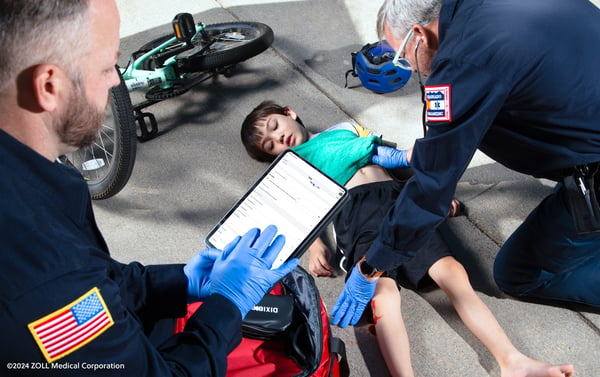Chart Smarter: Why One EMS Agency Ditched Paper for Mobile Tech
April Roundup: Mobile Device Best Practices, KPIs to Increase Your ROI, Benefits of GIS & More
If you haven't visited the ZOLL Pulse Blog in awhile, you've missed some really great content to help you in your day-to-day as EMS professionals

If you haven't visited the ZOLL Pulse Blog in awhile, you've missed some really great content to help you in your day-to-day as EMS professionals. Want to know why your software looks the way it does? We have an article for you. Looking to lower maintenance costs for your fleet? We've got you covered. Interested in how to leverage social media to help communicate with your community. Boom - we've got that too! Check out the following roundup to see what else you may have missed. And don't forget to subscribe to the blog, so you can receive all our great content directly in your inbox.
5 KPIs to Measure to Improve Fleet Safety & Savings
 Butler Medical Transport operates more than 67 ambulances throughout Maryland and Washington, D.C., Maryland doesn't allow 9-1-1 for commercial ambulance services, and most of our transports are non-emergency. The four percent of calls that are emergency calls we do are lights and sirens transports between facilities for critically ill patients coming from rural facilities. Last year, we put almost one and a half million miles on our ambulances, that's why safety and the amount of miles of traveled has become so critical. Knowing how to manage and interpret key performance indicators (KPIs) for fleet efficiency are key to a successful return on investment (ROI) for our safety program. With the dashboards within Road Safety, and our driver feedback system, these key pieces of data are at our fingertips. The following details the five KPIs we measure in order to improve fleet safety and savings at Butler Medical.
Butler Medical Transport operates more than 67 ambulances throughout Maryland and Washington, D.C., Maryland doesn't allow 9-1-1 for commercial ambulance services, and most of our transports are non-emergency. The four percent of calls that are emergency calls we do are lights and sirens transports between facilities for critically ill patients coming from rural facilities. Last year, we put almost one and a half million miles on our ambulances, that's why safety and the amount of miles of traveled has become so critical. Knowing how to manage and interpret key performance indicators (KPIs) for fleet efficiency are key to a successful return on investment (ROI) for our safety program. With the dashboards within Road Safety, and our driver feedback system, these key pieces of data are at our fingertips. The following details the five KPIs we measure in order to improve fleet safety and savings at Butler Medical.
How to Use GIS to Improve Billing, Operations & Responder Safety
Have you ever tried to geocode an incident for a motor vehicle crash using a milepost on a roadway or determine the best access point to a limited-access highway quickly and accurately? Arguably accuracy and speed are equally as important during incident creation. Are your billers cross-referencing a massive list of zip codes to a table of Geographic Practice Cost Index (GPCI) locals for proper charge selection during claim creation? Are your CAD operators looking at too many calls and units on their screens?
What Do Disney & EMS Software Have in Common? User Experience
 While EMS software may not be a trip to Disney World, ZOLL has made a commitment to expand the reach of UX design in our products. We are actively researching, learning and seeking to understand new ways to solve problems so “the latest technology can improve the lives of our users.” The following details why good UX matters and how we are striving to apply that to the software you use every day.
While EMS software may not be a trip to Disney World, ZOLL has made a commitment to expand the reach of UX design in our products. We are actively researching, learning and seeking to understand new ways to solve problems so “the latest technology can improve the lives of our users.” The following details why good UX matters and how we are striving to apply that to the software you use every day.
How to Manage a Media Crisis: External Communications with Reporters & the Public
In some ways, talking to patients, agency partners and the public through the media is the easiest part of a crisis. It’s also one of the most risky as it relates to protecting your EMS agency. The job of media outlets is to share the information of what’s happening with the public, but not necessarily to share that information in the way you want. Assuming you’ve already read through Part 1 of this series and already have your simplified and clarified message finalized, let’s jump right in to some best practices for talking to media during an emergency.
Protect Your EMS Agency, its Mobile Devices & Data
 It should come as no surprise by now that with advances in technology, the frequency of data loss and breaches is on the rise. It’s not just HIPAA breaches, either. Data breaches in general are big business both for thieves and those fighting and prosecuting them. This is especially true in the case of mobile technology – laptops, smartphones and other small devices – that can be easily misused, lost or stolen. Unfortunately, medical providers have been slow to adopt security protocols and response measures against inappropriate data disclosure and theft. What can you do to protect your organization, its mobile devices and data?
It should come as no surprise by now that with advances in technology, the frequency of data loss and breaches is on the rise. It’s not just HIPAA breaches, either. Data breaches in general are big business both for thieves and those fighting and prosecuting them. This is especially true in the case of mobile technology – laptops, smartphones and other small devices – that can be easily misused, lost or stolen. Unfortunately, medical providers have been slow to adopt security protocols and response measures against inappropriate data disclosure and theft. What can you do to protect your organization, its mobile devices and data?
How to Manage a Media Crisis: Communicating with Impacted Patients & Partner Agencies
The hardest and most important communications you have to handle during a crisis is to set the right tone and be responsive when sharing information to your agency partners and any impacted patients. Your customers are the ones who ultimately hold your EMS agency’s destiny in their hands. If you want to weather the storm, the easiest way is to protect and save what you already have secured. Assuming you’ve already read through Part 1 of this series and already have your simplified and clarified message finalized, let’s discuss the next section of this four-part series. How to communicate with impacted patients and your agency partners during a crisis.
Report: Mental Health & Emergency Responders

Suicide is now recognized as the leading occupational killer of emergency responders, according to a new report “Taking Care of Our Own: Mental Health Among Colorado Emergency Responders” released by ResponderStrong in collaboration with the National Mental Health Innovation Center. The report includes interviews from emergency responder department leadership from police, sheriff, state patrol, fire, EMS and dispatch branches in Colorado. “We were overwhelmed with the large number of responders to the survey; more than 55 percent of leadership from Colorado departments responded to the query of the survey,” said Rhonda Kelly, project manager for ResponderStrong during an interview with Colorado Public Radio’s (CPR) Colorado Matters.
Why Does Performance Matter in EMS?
If you have spent any time in EMS, chances are you have probably had a dispatcher (or two) say something along the lines of “whatever you can do to turn it around” or “you are going to have to drop and run, we have another call pending.” For many of us in busy EMS systems, this never-ending cycle is a daily occurrence, especially for those providers who perform non-emergent, routine transports. Why should a crew “turn it around quickly,” when the next call is just a discharge? Why does it matter? With the cycle seemingly spinning out of control, it can be easy to forget why performance matters, or why we should measure it in the first place.
Related Posts
The End of Delayed Documentation
4 Must-have Data Points for Dispatch-Billing Alignment and Maximum Reimbursement
ZOLL Pulse Blog
Subscribe to our blog and receive quality content that makes your job as an EMS & fire, hospital, or AR professional easier.
ZOLL Pulse Blog
Subscribe to our blog and receive quality content that makes your job as an EMS, fire, hospital, or AR professional easier.












